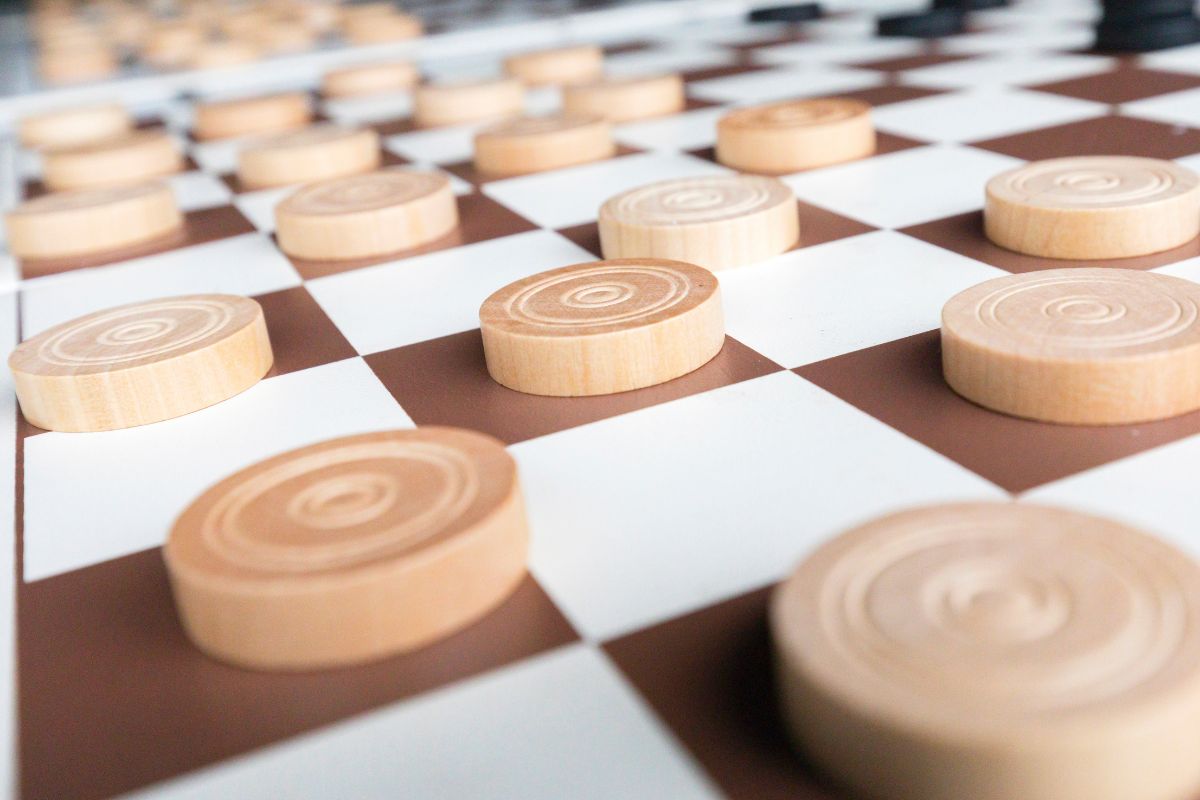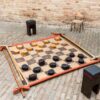Basic Rules of 100-Square Checkers
Checkers is one of the oldest and most popular strategic games in the world. In 100-square international checkers, which is one of the main variants of this game, two players participate, beginning with twenty pieces of different colors. Light-colored pieces are called white, while dark-colored pieces are called black.
The rules of checkers are well-defined and have their unique characteristics, making it an exciting and demanding game. In this article, we will present the basic rules of 100-square checkers, allowing you to quickly embark on an adventure with this captivating strategic game.
I. Initial Setup
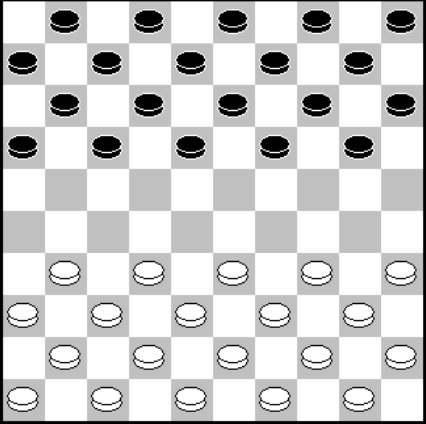
The pieces are set up in the first four rows on opposite sides of the checkerboard. White pieces are placed on the high numbers (50-31), while black ones are on the low numbers (1-20). There are two empty rows between the opponents’ pieces, similar to most variations of checkers.
II. Game Start and Progression

The game begins with the white pieces making the first move. A move is made by advancing a piece diagonally forward one square to an empty square on the checkerboard. Whites can start the game in 9 different ways (green). After making a move, the turn passes to the opponent.
III. Capturing Pieces
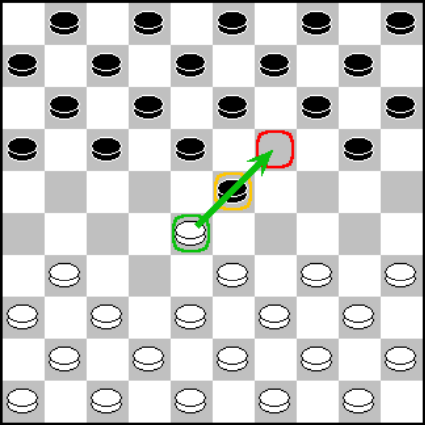
1. 32-28 19-23
When a piece of one color (yellow) lands on an adjacent square occupied by an opponent’s piece (green), and there is an empty square behind it (red), it jumps over to the square directly behind it (green arrow). This move is called a ‘capture.’ Captured pieces are removed from the board at the end of the move.

Capturing in checkers is mandatory, and you cannot waive it.
This fundamental rule is what makes checkers such a beautiful game. But what if the opponent doesn’t capture?
There are no ‘sorrows,’ ‘whistles,’ or sayings like ‘for not capturing, you lose a life.’ If a player fails to make a capture, thereby making an incorrect move, according to the official rules, his opponent has two options:
- Instruct the opponent to retract the incorrect move and make the correct capture,
- Continue playing. After the move is completed, even if it was incorrect, the opponent can choose to continue the game.
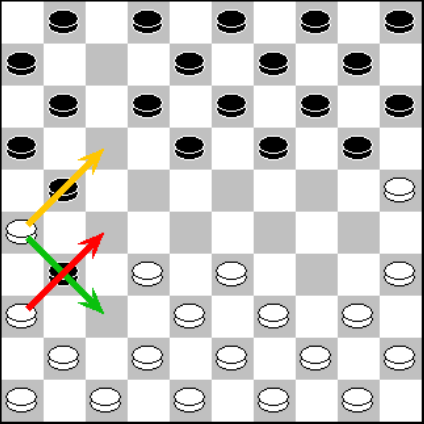
1.31-27 17-21 2.37-31 11-17 3.34-30 7-11 4.30-25 17-22 5.31-26 22×31
Unlike regular moves, capturing (as opposed to regular moves) can be done both forward and backward. In the depicted position, white pieces can choose any of the three captures: the yellow one forward, the red one forward, or the green one backward.
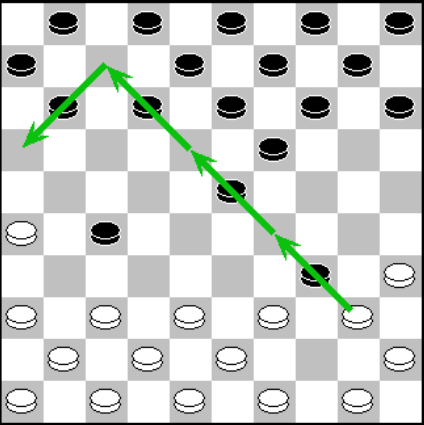
1.33-28 18-23 2.39-33 12-18 3.44-39 7-12 4.31-26 20-25 5.28-22 17×28 6.33×22 18×27 7.32×21 16×27 8.34- 30 25×34
In a single move, you can capture more than one piece. All captured pieces are removed from the checkerboard only after the capture sequence is completed, in the order in which they were jumped over (from start to finish or vice versa). In the example, the white pieces capture four black pieces, three of them by forward captures and one by a backward capture.
IV. Majority Capture Rule

White: 39, 38, 37, 33, 32 Black: 9, 13, 18, 19, 28
In international rules, the majority capture rule applies – if a player has several capture options, he must make the move that captures the greatest number of pieces. In this example position, white pieces have three capture options: 33×22 (capturing one piece), 32×12 (capturing two pieces), and 32×3 (capturing three pieces). Choosing the capture with the greatest number of pieces is not only the most advantageous but also the only correct move due to the majority capture rule.

Multiple capturing options?
If there are multiple options to capture the same number of pieces, the choice is arbitrary.
V. King
A piece that reaches the last row (the opponent’s first row), which is called the king’s row, becomes a king. A king is indicated by placing a second piece of the same color on top of it (crowning the piece). Placing a king (either through a move or a capture on the king’s row) ends the turn.
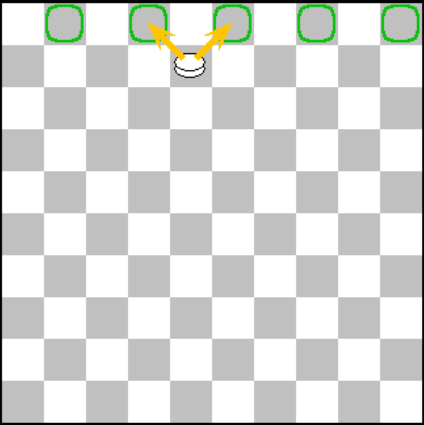
The king’s row for white pieces consists of squares 1, 2, 3, 4, and 5. A piece positioned on square 8 can be crowned as a king by moving it to either square 2 or 3.
Placing a king always ends the move.
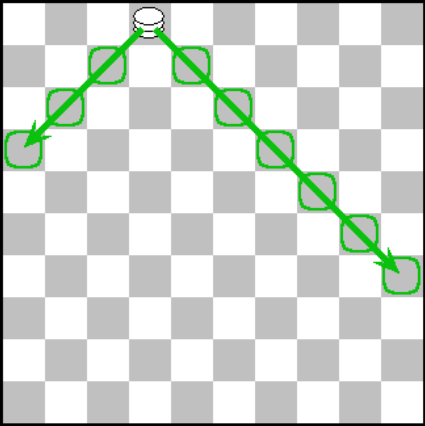
A king can move any number of squares diagonally along the diagonals it is on.
A white king positioned on square 2 is on the diagonals: 2-35 and 2-16. It can move to a total of 9 different squares: 7, 8, 11, 13, 16, 19, 24, 30, and 35.
VI. King's Capture
A king can capture one or more pieces diagonally along the diagonals it is on. The king can end the capture on any empty square on the diagonal beyond the last captured piece. However, a king cannot jump over two opponent pieces standing side by side (without an empty square between them). Like all pieces, a king is subject to the majority capture rule.

A king does not have priority in capturing over a regular piece.
If a regular piece and a king have the same number of pieces to capture, the choice of capture is arbitrary.
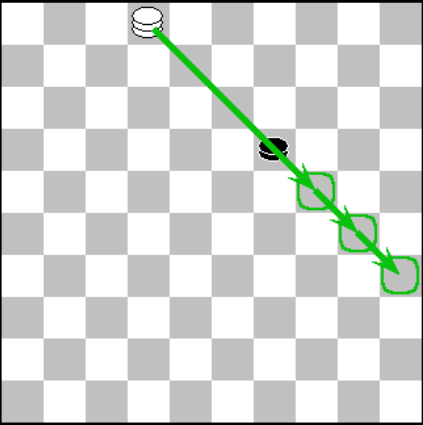
White: 2 (king) Black: 19
The black piece 19 is in the path of capture by the white king positioned on square 2. The king captures the piece by jumping over it and can land on any of the empty squares behind it: 24, 30, or 35.

White: 2 (king) Black: 9, 10, 19, 20, 22, 37
A king can perform captures involving more than one piece. On any empty square beyond the captured piece, it can change the direction of capture to a different diagonal.
The majority capture rule compels the king to capture the maximum possible number of opponent’s pieces. In the example position, the king captures piece 19, then lands on square 24, changes direction to a new diagonal to capture piece 20, then captures 10, 9, and 22, which are in line along one diagonal, and finally captures piece 37. The king’s capture sequence ends on square 42 or 48.

During a single capture, a king can pass through the same square multiple times, but it cannot capture the same piece twice.
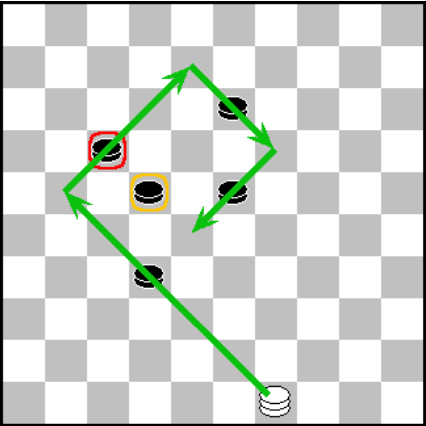
White: 49 (king) Black: 13, 17, 22, 23, 32
In the example, the white king 49 has many possible captures, with most of them resulting in capturing three black pieces. Only one sequence of captures allows for taking four pieces: 49x21x8x19x28 (green).
Only after completing the capture can the collection of captured pieces begin: 32, 17, 13, and 23. There remains a single black piece on square 22 (yellow) on the checkerboard. The white king couldn’t jump over it because such a maneuver would require capturing piece 17 (red) for the second time, which is not allowed.
VII. Regular Piece Capturing on King's Row
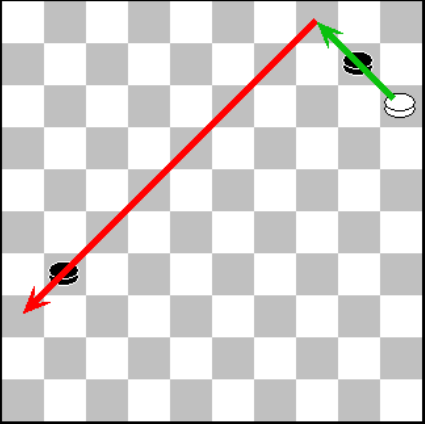
White: 15 Black: 10, 31
The white piece 15 captures the black piece 10 (green) and becomes a king on square 4. Placing a king always ends the move. On the diagonal of the king 4-36 (red), there is another black piece (31), but the king cannot capture it because it is black’s turn. Piece 31 can escape from being captured by the white king.
VIII. Regular Piece Capturing Through King's Row
A piece that captures onto the king’s row and can continue capturing as a regular piece will do so and does not become a king.

White: 15 Black: 9, 10, 18, 26
The white piece 15 captures the black piece from square 10 and lands on square 4, which is the king’s row. However, it can continue capturing the black pieces 9 and 18 as a regular piece. In this case, it captures the mentioned black pieces without becoming a king (green).
IX. The Objective of International Checkers
The objective of the game in international checkers is to deprive the opponent of the ability to make a move. This objective can be achieved in two ways:
- By capturing all the opponent’s pieces (regular pieces and kings),
- By blocking all the opponent’s pieces.
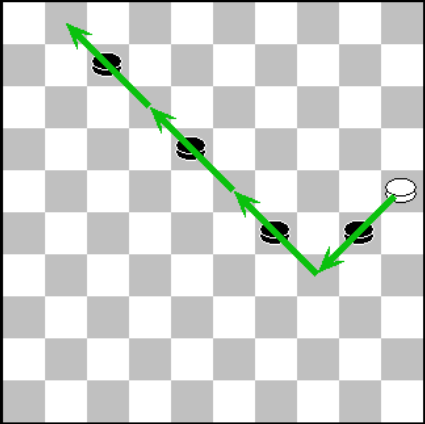
White: 25 Black: 7, 18, 29, 30
The white piece 25 captures all the black pieces (green), concluding the game with a victory.
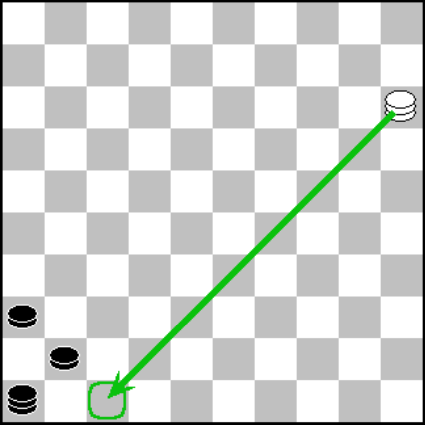
White: 15 (king) Black: 36, 41, 46 (kings)
The white king moves to square 47 (green). None of the black pieces that move downward on the checkerboard have any legal moves. White wins the game.
X. Draw
A game of checkers ends in a draw when neither player can achieve the objective of the game. Players may agree to a draw through mutual consent.

White: 47 (king) Black: 1 (king), 5 (king)
Typical drawn positions are situations where both sides have kings, such as one king against one king, two kings against one king, or two kings against two kings.

Furthermore, a game is considered a draw when:
- The same position has occurred three times, with the same player to move each time,
- For 25 consecutive moves, both players have moved only kings, without any regular piece moves or captures,
- If both players make 25 moves each with kings, without any regular piece moves or captures, the game ends in a draw by the rules.
Improve Your Skills
If you want to delve into the intricacies of international checkers and enhance your skills, there are numerous options available. You can play with friends or join a local checkers club, where you’ll meet other enthusiasts of this wonderful game. Additionally, there are many educational materials, guides, and online resources that can assist you in expanding your knowledge of checkers and refining your strategy.


